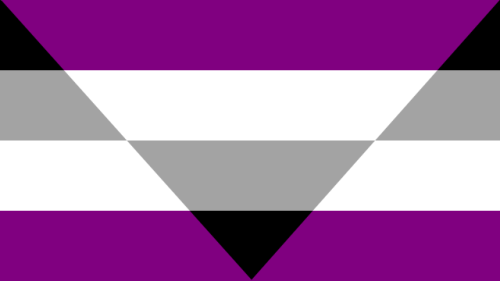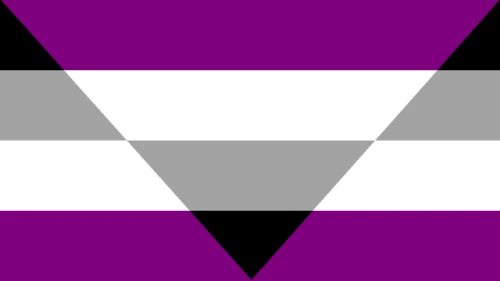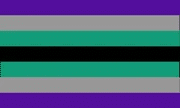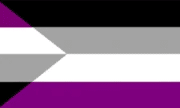Aegosexual – What is it? What does it mean?
 Aegosexual flag
Aegosexual flag
Aegosexual, a term formerly known as autochorissexual, is a sexual orientation that falls under the asexuality umbrella. The reason the term is now known as aegosexual is that the orientation’s original perception was associated with paraphilia.
Aegosexual people lack the desire to be involved in sexual activities themselves. Aegosexuals experience sexual attraction and sexual arousal in different ways. Aegosexuals are aroused by sexual content, pornography and may enjoy masturbation but they only enjoy sexual fantasies. An aegosexual individual does not want to have sex with another person. Despite this, you still might meet aegosexual (asexual) individuals on dating sites or apps.
Table of Content
Aegosexual is a sexual identity that is part of the asexual spectrum. Aegosexuals may feel disconnected from the feelings of sexual arousal they experience. This wiki will delve into what it means to be aegosexual, the history behind the word, how to explore and feel comfortable in your aegosexual identity, and how to be a good advocate.
Terminology
Here are some words and phrases you need to know to understand aegosexuality.
Aegosexual
Aegosexual is a sexual orientation that is part of the asexual spectrum. Aegosexuals experience sexual attraction, but feel a detachment between themselves and the idea of participating in sexual activities. In other words, someone who is aegosexual may feel arousal or attraction about fantasies or scenarios, but don’t realy want to engage in acts themselves. The whole word breaks down into A (without) ego (self) and sexual.
It’s important to remember that each person who identifies as aegosexual experiences sexual attraction differently. Some may prefer to fantasize and have thoughts about sex, but never engage in sex acts. Others may be fine with engaging in sex with others. These differences are way some people have constructed other definitions of the word that support different takes on different experiences while remaining true to the same meaning of it.
Autochrissexual

This was the original word for people who experiences arousal without a feeling of personal connection to their fantasies. It was originated by Dr. Anthony Bogaert a psychologist specializing in human sexuality. However, he deemed it a psychological disorder. Because of that, the word was replaced with aegosexual. This was coined by Tumblr user Sugar-and-spite.
Asexual
This is a sexual orientation in which individuals don’t feel sexual attraction and desire in the way that others do. There is a range of identities that fall within the asexual spectrum. Members of the asexual community may feel no sexual desire at all or may experience limited sexual attraction.
Sexual Attraction
Sexual attraction is the feeling a person experiences when they have sexual desire towards a specific person or object.
Sexual Arousal
This is a physical sensation caused by thoughts, hormones, talk, and contact. There are some physical changes associated with sexual arousal such as erections, vaginal lubrication, changed breathing, etc. Sexual arousal can happen on its own or be a result of sexual attraction.
Graysexual
This is a person who identifies as asexual, but will still have sexual relationships ocassionally.
Allosexual
The opposite of asexual. These are the folks who experience sexual attraction and seek out sexual relationships.
Romantic Orientation
Who do you want to have romantic relationships with? That is your romantic orientation.
Sexual Orientation
Sexual orientation is the group of people you find to be sexually attractive.
Sex-Repulsed
These are individuals who are repulsed at the idea of sex. Some are even so against sex that they don’t engage in masturbation.
Fictosexual
A sexual orientation where the person feels sexual attraction towards fictional characters.
Aegoromantic
Similar to an aegosexual, but in this case the person experiences detachment from romantic thoughts or fantasies.
History
Aegosexual is a relatively new term without much history behind it. Still, it’s worth exploring the definition a bit more, and the evolution of this sexuality. Unlike other orientations, this one along with the community around it has largely developed in internet spaces like Tumblr.
Aegosexuality is a nuanced category of human sexuality. It refers to individuals experiencing a disconnect between feeling attracted sexually and engaging in real-life sexual relationships. Its academic roots come from Latin. People have described it as having the perspective of an outsider. That’s because aegosexuality involves imagining yourself or even involves generic faceless individuals when visualizing sexual content or erotic content. There’s often no direct connection between one’s fantasies and one’s personal desires.
The concept of aegosexual is tied directly to Bogaert’s definition of asexuality. He explored non-sexual attraction and unique relationship dynamics among people who fall into that category. Part of that might include fantasies or media involving fictional characters. Some will imagine scenarios with realistic elements, but never feel inclined to act out these fantasies in real life. In a sense, it’s a way of mimicking sexual attraction without taking part or feeling any motivation for physical connection.
The aegosexual community first came to life on platforms like Tumblr. There, users like Sugar-and-spite and Hunterinabrowncoat discussed this orientation at length. People who took part in Tumblr communities were able to discuss being aegosexual at length. These are the online spaces in which people have explored definitions of the term, clarified misconceptions about it, and shared their own experiences with it. For some, this was a new or alternative label for how they’d always felt. For others, it opened up new possibilities for identifying themselves.
One key aspect of aegosexuality is that it involves thinking through sexual scenarios as something of a disembodied observer viewing things from the outside. This allows the individual to engage in the idea of sex without feeling any pressure to participate directly. Some people add realistic elements to make the fantasies more appealing, but still feel negatively about translating fantasy to real life sexual experiences.
There is much diversity within the experience of human sexuality. Adding aegosexuality to that mix reflects that. It shows that experiencing attraction does not always include a desire to make a real-life connection. There’s a spectrum in how people resonate with sexual attraction and desire. It’s also proof that the ways in which people engage with sexual content and sexual fantasies varies widely.
Flag and Symbols
There are aegosexual flags and symbols that showcase the nuances of this sexual orientation. Aegosexuality which is rooted in Latin words that translate to self and sexual provides individuals with a way to self-identify. Flags and symbols offer a way to show pride in that identity.
 Aegosexual flag
Aegosexual flag
This is the original aegosexual flag designed by Tumblr user Hunterinabrowncoat. It has teal, purple, blac, and gray stripes. The teal represents attraction from a third person perspective. Purple represent sexuality or mimics sexual attraction to show community and sexuality. Black represents asexuality. Finally, the gray represents the orientation’s original classification as part of the gray-asexual spectrum. The triangle represents the opposite of asexuality as aegosexuals may be perceived as sexual people
 Alternate aegosexual flag
Alternate aegosexual flag
There is also another version which features the inverted triangle but uses the colors of the alternate flag.
 Alternate aegosexual flag
Alternate aegosexual flag
A fourth version of the flag was created online in February 2021. The shades of purple represent sexuality whereas the black triangles represent a disconnect between sexuality and oneself. The grey X stands for the grey asexual spectrum.
 Alternate aegosexual flag by Cryptocrew
Alternate aegosexual flag by Cryptocrew
Am I an Aegosexual?
Think of the widely used definition of aegosexual. It’s feeling a sense of disconnection between your attraction and an actual involvement in real-life sexual relationships. If that resonates with you, then you might be an aegosexual. For example, if you’re an aegosexual, you might enjoy reading or watching erotic content. The difference is that you enjoy these from a third individual perspective or via generic participants instead of imagining oneself in the scenarios. Some people add realistic elements or will imagine varying takes on a fantasy involving even friends or associates without getting personally involved.
Some people aegosexuality means enjoying sexual themes, but feeling negatively about being directly involved. That’s why an aegosexual individual will often avoid imagining themselves taking part in sexual content they see or imagine. Instead, they engage from a detached viewpoint. This even happens when the situation includes people who are familiar to them.
If you identify as an aegosexual person, it’s helpful to address any negative association you have with this identity. Keep in mind that it isn’t a personality flaw or moral failing. It’s simply a way of engaging with sexual feelings and the world.
How do you understand yourself better and learn to embrace your sexuality? Here are some steps you can take:
- Find support – Many groups for asexual individuals also have resources for aegosexual folks
- Learn about and nurture your own sexuality – You deserve to feel fulfilled, however that looks for you. This includes enjoying sexual content in a way that works for you.
- Set boundaries – Not everyone will understand your sexuality. It’s okay to educate others. At the same time you’re not obligated to do that emotional labor.
- Journal to better understand yourself – Explore your feelings and experiences by writing them down.
- Explore your fantasies – Spend time enjoying erotic content. Make your own fantasies and try adding realistic elements to see what brings you the most enjoyment.
How to Support an Aegosexual
If someone you care about identifies as aegosexual, you can say and do things to support them. First, keep in mind that this isn’t a negative thing and it doesn’t need to be fixed. If the person you know is struggling with this realization or facing negativity from others, you can certainly be a source of support. Just avoid assuming that this is something bad or that it comes from a place of trauma. Your loved one simply experiences sexual attraction and arousal differently than you might.
The best thing you can do is validate your friend’s identity, and thank them for sharing with you. When you do that, you establish that they are safe being themselves and discussing this with you. That kind of validation is often all a person needs.
From there, let the person you know set the tone. Some may be interested in talking it out and having someone act as a sounding board while they process and accept. Others simply see this as a part of who they are. Take guidance from them while also taking time to educate yourself. Finally, never assume what this identity means for anyone or how it plays out in their choices. Each person will express this identity differently and make different choices as to how they integrate their sexuality into their life.
Gallery
Another version of the aegosexual flag available online
 Alternative Aegosexual flag by Pringles ketchup the second
Alternative Aegosexual flag by Pringles ketchup the second
Possible alternate aegosexual flag:
 Possible alternate aegosexual flag
Possible alternate aegosexual flag
Another alternate version of the aegosexual flag:
 Alternate version of the aegosexual flag
Alternate version of the aegosexual flag
Resources
https://asexualitytrust.org.nz/what-is-asexuality/attraction-vs-arousal/
https://www.webmd.com/sex/what-is-graysexuality
https://www.choosingtherapy.com/romantic-orientation/
Share this post:
What do you think?
 Aegosexual flag
Aegosexual flag


